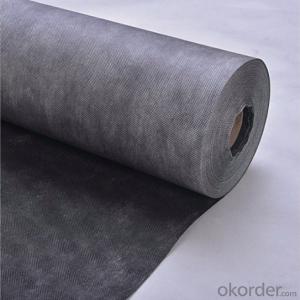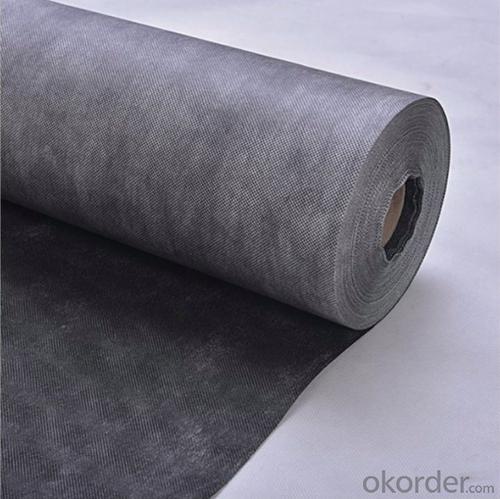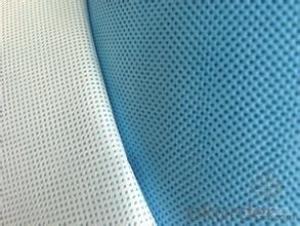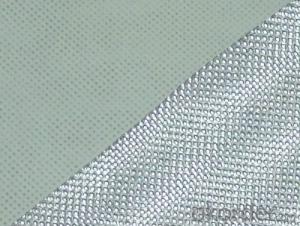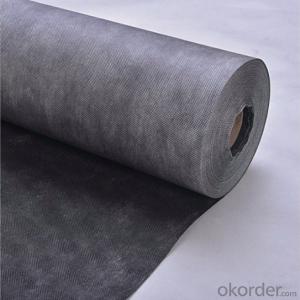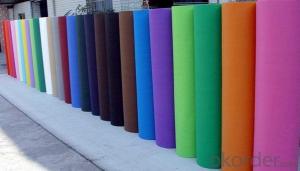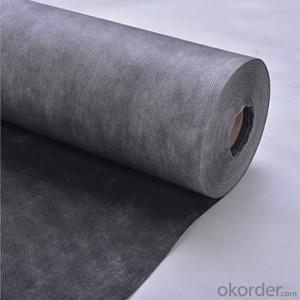Non-Woven Waterproof Breathable Membrane Roof Liner Foil Breathable Membrane For House Wrap
- Loading Port:
- SHANGHAI
- Payment Terms:
- TT OR LC
- Min Order Qty:
- 500 m²
- Supply Capability:
- 100000 m²/month
OKorder Service Pledge
OKorder Financial Service
You Might Also Like
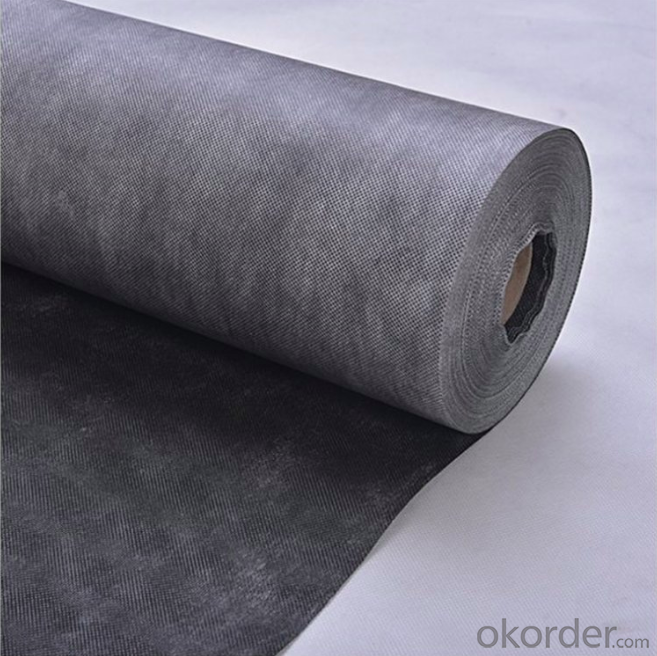
Product Feature:
Air open & vapour permeable
More breathable than any other 'air open' underlay on the market
Lowest vapour resistance of all breathable membranes
Being both air open & vapour permeable further minimises the risk of condensation forming
No ventilation required
Strong 3 layer material
Superior nail tear strength
| Mass per unit area: | 140g/m2 |
| Product Type: | Waterproofing Breathable Bembrane For House Wrapping |
| Material: | PP/PE granule |
| Tensile Strength(MD/XD): | 190N/5cm(+-20%)/150N/5cm(+-20%) |
| Resistance to tearing(MD/XD): | >50N/50N |
| Flexibility at low temperature: | (-)24°C |
| Resistance to water pentration: | W1 |
| Temperature resistance | (+)70°C |
| Resistance to UV | 3momths |
| Loading quantity | 40' HC ---2000rolls |
Our company :
our company is a leading professional manufacturer in China, which locates in Yangzhou State-grade Development Zone,Yangzhou City, Jiangsu Province, nearby Shanghai.
We have advanced production lines with the technology from Italy and Germany, which are applied to nonwoven products, film lamination, roofing materials, disposable medical products, packaging materials and so on.Main products:Nonwoven fabric , SMS, SMMS and manufactured productsFilm or foil laminated products Roofing membrane, flooring underlayPE woven fabric, PE tarpaulin, vapor barrierGreenhouseWe not only have first-class processing line, but have first-grade quality management. We have been qualified by ISO9001 (quality) and CE, this system can supply active way to guarantee the quality. We have exported to many countries, such as Canada, USA, Chile, Argentina, New Zealand, Australia, Malaysia, Japan, Ukraine, Latvia, Slovenia, Slovakia, Spain, CZ, Russia, Croatia, Bulgaria, Romania, Italy, UK, Germany, Greece and so on. With a group of excellent senior management and hi-tech R& D personnel and our skilled workers, we can supply you the goods with competitive prices and better quality. We look forward to establish friendly and long term relationship with you in the near future.
FAQ:
1. who are we?
We are based in Jiangsu, China, start from 2008,sell to Eastern Europe(18.00%),Southern Europe(15.00%),Northern Europe(15.00%),Western Europe(12.00%),South Asia(6.00%),Eastern Asia(5.00%),Oceania(5.00%),Central America(5.00%),Southeast Asia(5.00%),North America(3.00%),South America(3.00%),Africa(3.00%),Domestic Market(3.00%),Mid East(2.00%). There are total about 11-50 people in our office.
2. how can we guarantee quality?
Always a pre-production sample before mass production;
Always final Inspection before shipment;
3.what can you buy from us?
Breathable Membrane, Reflection Breathable Membrane, Housewrap, Vapor Barrier, Heat Insulation Film
4. why should you buy from us not from other suppliers?
We not only have first-class processing line, but have first-grade quality management. We have been qualified by ISO9001 (quality) and CE, this system can supply active way to guarantee the quality. We have exported to many countries, such as Canada, USA,
5. what services can we provide?
Accepted Delivery Terms: FOB,CFR,CIF,EXW;
Accepted Payment Currency:USD,EUR,JPY,CAD,HKD,CNY;
Accepted Payment Type: T/T,L/C,Credit Card,PayPal,Western Union,Cash;
- Q: Can a waterproofing membrane be used in swimming pools or other water features?
- Certainly, swimming pools or other water features can indeed utilize a waterproofing membrane. In fact, it is highly advisable to employ such a membrane in these areas to avert water leakage and potential harm. By serving as a barrier between the water and the surrounding structures, a waterproofing membrane ensures that the water remains contained within the pool or water feature. Not only does it prevent water seepage, which can inflict structural damage and necessitate expensive repairs, but it also safeguards the pool or water feature from the harsh chemicals employed for water treatment, thereby guaranteeing its durability and long lifespan. Consequently, the utilization of a waterproofing membrane is an essential measure in the construction or renovation of swimming pools or other water features, guaranteeing their functionality and longevity.
- Q: Can a waterproofing membrane be used in conjunction with soundproofing materials?
- Yes, a waterproofing membrane can be used in conjunction with soundproofing materials. While the primary function of a waterproofing membrane is to prevent water infiltration, it can also contribute to sound insulation to some extent. However, for optimal soundproofing, it is recommended to use dedicated soundproofing materials such as acoustic insulation or soundproof panels in addition to the waterproofing membrane.
- Q: Can a waterproofing membrane be used for a bridge deck?
- Indeed, a bridge deck can utilize a waterproofing membrane. In fact, it is customary to employ a waterproofing membrane on bridge decks to safeguard the structure against moisture infiltration, which may result in corrosion and deterioration. A waterproofing membrane acts as a protective shield, preventing water from permeating the concrete deck and ensuring the bridge's longevity and durability. Additionally, it can aid in minimizing the risk of freeze-thaw damage, which is particularly crucial in regions with severe weather conditions. All in all, the implementation of a waterproofing membrane on a bridge deck is a dependable approach to prolong its lifespan and preserve its structural integrity.
- Q: What type of maintenance is required for a waterproofing membrane?
- To properly maintain a waterproofing membrane, regular inspections and routine maintenance are necessary. Firstly, it is important to keep the surface clean and free from debris that could potentially damage the membrane. Regularly remove any dirt, leaves, or other foreign materials that may accumulate on the surface. Inspect the membrane for any signs of wear, tear, or damage, such as cracks, blisters, or punctures. If any issues are found, they should be repaired promptly to prevent water leakage and potential further damage. Additionally, it is recommended to inspect and maintain the surrounding areas of the membrane, including gutters, downspouts, and drainage systems. Ensure that these components are functioning properly and free from any blockages that could compromise the effectiveness of the waterproofing system. Depending on the type of waterproofing membrane used, it may require periodic reapplication of a protective coating or sealant. This will help to extend the lifespan of the membrane and ensure its continued effectiveness. It is also essential to monitor the membrane's performance during heavy rain or snow events. Check for any signs of water pooling or leakage, and address any problems promptly. Overall, regular inspections, routine cleaning, prompt repairs, and necessary reapplication of protective coatings are key maintenance tasks to ensure the longevity and effectiveness of a waterproofing membrane.
- Q: Can waterproofing membranes be used on concrete fountains?
- Yes, waterproofing membranes can be used on concrete fountains. Concrete fountains are often exposed to water and can be prone to leaks and moisture damage. Applying a waterproofing membrane to the concrete surface helps to create a barrier that prevents water penetration and protects the fountain structure. Waterproofing membranes are designed to be flexible, durable, and resistant to water, making them an ideal solution for concrete fountains. They can be applied to the interior and exterior surfaces of the fountain, ensuring complete protection against water damage. By using waterproofing membranes, the lifespan of the concrete fountain can be extended, and maintenance costs can be reduced.
- Q: Can a waterproofing membrane be used on tunnels with seismic protection systems?
- Yes, a waterproofing membrane can be used on tunnels with seismic protection systems. The membrane acts as a protective barrier against water infiltration, which is important for maintaining the structural integrity of the tunnel. The seismic protection systems, on the other hand, are designed to absorb and dissipate the energy generated by seismic events, reducing the risk of damage to the tunnel. These two systems can work together to enhance the overall safety and durability of the tunnel infrastructure.
- Q: Can a waterproofing membrane be used on cinder block surfaces?
- Yes, a waterproofing membrane can be used on cinder block surfaces. It provides an effective barrier against water penetration and helps to protect the cinder block from moisture-related damage.
- Q: Can waterproofing membranes be used on metal roofs?
- Yes, waterproofing membranes can be used on metal roofs. Waterproofing membranes are a popular choice for protecting and sealing roofs, including metal roofs. These membranes are designed to provide a barrier against water penetration, protecting the roof structure and preventing leaks. They can be applied directly to the metal roof surface, creating a watertight seal that is resistant to moisture, UV rays, and other environmental factors. Waterproofing membranes can effectively extend the lifespan of metal roofs by preventing rust and corrosion, while also improving energy efficiency by reducing heat transfer. Therefore, using waterproofing membranes on metal roofs is a viable and effective solution for ensuring durability and longevity.
- Q: Can a waterproofing membrane be used on terraces or patios?
- Yes, a waterproofing membrane can be used on terraces or patios to prevent water penetration and protect the underlying structure from moisture damage.
- Q: Can a waterproofing membrane be used for a water tank sealant?
- Indeed, a waterproofing membrane can serve as a sealant for water tanks. These membranes are specifically engineered to obstruct water flow and are extensively employed for sealing diverse structures, such as water tanks. They furnish a robust and efficient shield against water penetration, thus safeguarding the tank from leaks and potential harm. Nevertheless, it is crucial to verify that the chosen waterproofing membrane is explicitly designed for water tanks and adheres to the required standards and regulations for the particular use. Additionally, it is advisable to seek guidance from a professional or a reputable manufacturer to guarantee the utilization of the correct product and installation technique for optimal performance and longevity.
Send your message to us
Non-Woven Waterproof Breathable Membrane Roof Liner Foil Breathable Membrane For House Wrap
- Loading Port:
- SHANGHAI
- Payment Terms:
- TT OR LC
- Min Order Qty:
- 500 m²
- Supply Capability:
- 100000 m²/month
OKorder Service Pledge
OKorder Financial Service
Similar products
Hot products
Hot Searches
Related keywords
